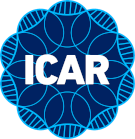Wiki:About
What is ICAR?
The aims of objectives of the International Committee for Animal Recording (ICAR) are described here on the ICAR website.
About the ICAR Guidelines
Scope
The ICAR Guidelines attempt to provide the world-wide farm livestock recording sector with detailed standards and guidelines representing the state-of-the-art for the full range of activities involved in the identification, performance recording and evaluation of farm livestock.
Changes and Limitation of Liability
See the Wiki:General disclaimer page.
Copyrights
Intellectual property rights apply to the contents of the ICAR Guidelines, including copyrights, database rights and trademark rights. You are not entitled to exploit, multiply or otherwise trade any of the contents of the ICAR Guidelines without express prior written approval of ICAR. Contact ICAR for more information about the use of the material contained in the ICAR Guidelines.
Languages
English is the official language of the ICAR Guidelines. ICAR members are encouraged to translate relevant parts of the ICAR Guidelines to their own languages noting:
- There is no need for an official translator but the person(s) doing the translation must be familiar with English, the subject matter, and a native speaker of the language translated into.
- The is no need to keep the original format and translators are free to adapt the style most appropriate for the language being translated into.
- Being a translation, there is no need for any ICAR official approval. Just add at the beginning of the translated Guidelines a disclaimer, stating that the original English text is the approved version and include a link to the guidelines section of the ICAR website or the relevant section which has been translated.
- Where a translation has been carried out a certified copy in the language must be provided to ICAR who will make it publically available via the ICAR website. ICAR is not responsible for any errors in translation.
Copies
The latest version of the ICAR Guidelines is available here from the ICAR web site.
Purpose of the ICAR Guidelines
The ICAR Guidelines have been developed and are maintained by ICAR for a number of purposes as described below.
Standards
To provide standards for animal recording which ensure the equivalence of animal recording results collected and or reported by ICAR members world-wide.
Reference
To provide practitioners in the field of animal recording with descriptions of procedures and practises which are that state-of-the-art.
Certification
To provide detailed descriptions of the standards, and procedures which are followed by ICAR in providing certifications.
Basic Principles
Recording
- Herd/Flock - Any group of animals kept for the same purpose and at the same location shall be regarded as a whole herd/flock. For a record to be considered an official record, the whole herd as defined above must be recorded.
- Identification - Every animal in a herd/flock must be uniquely identified using a official system approved for the country in accordance with Section 10 of the Guidelines.
- Base record - Every animal should have accurate basic data recorded including birth date, sex, ancestry, date of movement in and out of the herd/flock, and date of death, in accordance with Section 1 of the Guidelines.
- Trait records - Every trait recorded for an animal should be recorded in accordance with the relevant section of the ICAR Guidelines.
- Records of characteristics of production systems should be true indicators of the state of animal health, animal care, food safety and the environment and be recorded in accordance with the relevant section of the ICAR Guidelines.
Evaluation
Genetic evaluation of traits of an individual animal must be carried out per the descriptions in the various species guidelines.
Supervision and quality assurance
- All Members involved in recording and or evaluation related activities shall establish a system of supervision.
- Associate Members involved in production of identification, recording and analytical devices should establish the system of quality control and quality assurance.
- For the purpose of these Guidelines, the recognized quality assurance systems are ICAR Certificate of Quality and ISO accreditation.
Publication of results
- Published records should furnish a true indication of an animal's performance, parentage and genetic merit. Official records and certificates may be issued only by member organizations and by organizations approved by them.
- All published official records should be to a standardized basis as described in the ICAR Guidelines.
- In all cases the publication of the official record should indicate the methods used as given in the ICAR Guidelines.
- Where the record includes estimates of missing data, it must so state.
- The breed, sex and unique identity of the animal and the sire and dam of the animal and of their sires and dams and the animal's date of birth, should be shown on the official records, where these are known to the Recording Organization.
- Where the record has been significantly affected by the health of the animal, the record should so state.
- Where the record has been significantly affected by an unusual management practice and/or environmental conditions, the record should so state.
- Details for the publication of records are given in the ICAR Guidelines on Individual Animal Certificates.
